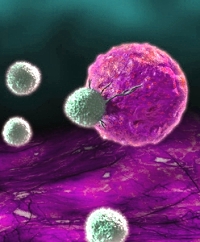|
The first step of peptide selection in antigen presentation by MHC class I molecules
Malgorzata A. Garstka, Alexander Fish, Patrick H. N. Celie, Robbie P. Joosten, George M. C. Janssen, Ilana Berlin, Rieuwert Hoppes, Magda Stadnik, Lennert Janssen, Huib Ovaa, Peter A. van Veelen, Anastassis Perrakis, and Jacques Neefjes
PNAS (2015) 112: 1505-10
The major histocompatibility complex (MHC) class I molecules display a wide array of peptides to the cytotoxic T cells, providing for the immune system to attack the pathogens and mutated proteins. However there is a limited set of peptides that is presented, and how this selection occurs is the focus of this paper, in which the peptide on- and off-rates from the mouse MHC class I molecule H-2K were studied.
The authors found that these molecules initially bind a large number of peptides, but that this initial step is followed by a selection where the majority of these peptides are released. They found a strong temperature dependency by the H-2Kb peptidome from cells cultured at 26 °C versus 37 °C, suggesting that the MHC class I undergoes rounds of consideration and rejection until only high-affinity peptides are acquired. This mechanism simultaneously allows for a wide range of sampling while ensuring that only the best available options are chosen for presentation.
|
 |